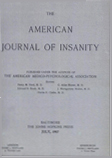Abstract
Routine reports of all accidental injuries to patients of Danvers State Hospital were collected for a two-year period, including even those accidents which were so trifling as to result in no visible injury. These reports were analysed statistically with reference to such factors as age of patient, time and place of occurrence, causative factors, nature of injury, treatment required, and personal responsibility for the accident.
The number of accidents reported for the two-year period was 4755, an average of slightly over one accident per year for each patient of the resident population.
The accident rate for female patients was appreciably higher than for male patients.
The very young patients and the very aged ones suffered more accidents, in proportion to their numbers, than those of any intermediate age group.
More accidents occurred in the latter part of the forenoon than at any other time of day. The accident rate per hour was lower at meal times than at any other time of the waking day.
The most common cause of accidents was personal violence on the part of some other patient. The most common weapon used by patients, especially female patients, was a shoe held in the hand. With or without a weapon, there were many more assaults reported among the women than among the men.
The accidents include 56 suicidal attempts, three of which resulted in death.
The accidents counted as serious number 413, or 8.7 per cent of the total number. These included 106 fractures and 251 lacerations which required closure by sutures. A detailed analysis was made of these serious accidents, especially with reference to their causes.
This study offers definite indication that many accidents are directly traceable to over-crowding of wards, insufficiency of personnel, and other environmental factors which are beyond the immediate control of any individual state hospital. However, without waiting for desirable changes which should be brought about gradually, we can offer recommendations concerning a few practical measures which may be expected to lower the accident rate. For example, so simple an expedient as the use of rubber-soled shoes in the female wards might render some of the unavoidable accidents less serious.
We believe that similar studies conducted in other institutions, based essentially upon reports of routine investigations, might contribute importantly to our resources for prevention of accidental injuries in state hospitals.
Note:—The authors wish to acknowledge the assistance, in farming this report, of Neil A. Dayton, M. D., Leo Maletz, M.D., and Grace H. Kent, Ph. D.

